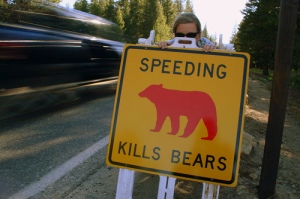A lot has been made of the impact the oil sands are having on wildlife in or passing through the area. But not a lot has been made of the bigger picture.
A Bit of History
April 2008 sucked. It sucked for birds. It sucked for workers. It sucked for the industry. It sucked. It sucked a lot.
In 2008 over 1,600 birds died in a Syncrude tailings pond. The company is currently in court facing “charges under Section 5.1 of the Migratory Birds Convention Act and Section 155 under the Alberta Environmental Protection and Enhancement Act.” [source] If you are interested, Syncrude has a dedicated Waterfowl Trial page with audio clips covering their lawyer’s responses to media outside the courtroom.
Needless to say, this regrettable incident has garnered a lot of negative press for Syncrude, the industry and the region. There are over 1,000,000 hits on Google while searching for “oilsand ducks“… the first one is a CTV article titled “Canada’s image hurt by oilsands duck deaths: PM – CTV News“.
This is a very graphic, very concentrated and very “unusual” event – in fact, it makes for a good, news story (note: *not* a good news, story). It’s interesting, it grabs the attention of the reader/viewer and people can picture it in their minds. The world has read, viewed and discussed the incident… and the scuttlebutt has not been kind.
Aside from the bird deaths, a report was recently unearthed in regards to oil sands-related wildlife deaths between 2000 and 2008:
“Documents obtained by Greenpeace, under freedom of information legislation, show that at least 164 other animals died during oil sands operations between 2000 and 2008.
Those animals included 27 bears, 67 deer, 31 foxes and 21 coyotes.” [CTV.ca]
Again, this is not looking good. No one likes to hear about animals suffering due to the industry’s impact on the environment (no matter if they died due to the actual operations on site, or other causes, which took place on site). Which is why all of the negative press around the oil sands and wildlife makes me angry – because there have been little, if any, posts, articles or feeds that bother trying to bring a balanced point of view to the topic.
Why This Post
The Toronto Star published a small piece yesterday entitled “Oil industry isn’t heartless toward wildlife” – in fact, it started me musing about this post… because when we look at how other industries or practices impact wildlife, the numbers in the oil sands aren’t looking so horrific. Specifically, let’s quickly look at two other areas: Buildings & Vehicles
What About A Clear Picture (Window)?
A large source of wildlife deaths are the buildings we live and work in. For instance, there is one particular complex in Scarborough, the office buildings at 100-300 Consilium Place, that is considered a “death trap” for birds.
The Toronto Star reported on March 9, 2010, that:
“In 2008-2009, more than 800 birds were recovered from the lawns around the complex, ironic considering it was awarded a “Go Green certificate of achievement” for its environmental practices by the Building Owners and Managers Association of Toronto. Go Green certificates are most commonly awarded for energy efficiency.
Over the past decade, more than 7,000 birds of 82 species have met painful deaths after flying into what bird safety advocate Michael Mesure calls ‘the most reflective glass windows of any building in the city.'”
So let’s look at that again: over 7,000 birds have died. From just 3 buildings. 3 buildings, 10 years, 82 species, 7,000 birds. Where is the international outrage? Where are the calls from Europe demanding environmental justice? Where are the protesters repelling down the sides of the buildings unfurling banners?
This is but one example of how buildings are impacting our friends in the sky. Just imagine how many similar buildings dominate the skylines of Canada’s major cities… how many birds have met the same fate across our country? Across the contient? Across the developed world?
An Object in Motion….
Let’s take a look to see how the vehicles we drive impact wildlife. I’m not going to get into any environmental impacts, or migration impacts etc. I’m only going to look at what happens when an object in motion tends to stay in motion. Let’s look at vehicle/animal collisions.
First up is Ontario, and how many animals are reported to be involved in vehicle collisions.
“In 2007, 13,954 collisions were reported. Many more go unreported.” And those are just the reported numbers. 13,954 collisions. That works out to an average of one collision every 38 minutes on the roads of Ontario. [source]
According to statistics from the Government of Alberta’s Transportation Ministry, about 11% of all reported traffic collisions in 2005 involved wildlife. In 2008, the Transportation Ministry reported that there were over 158,000 reported collisions. If the 11% trend holds true, then that suggests close to 17,000 animals were involved.
Now, staying within my home province of Alberta, 17,000 animals were involved in reported traffic collisions in 2008. Compare that to the 1,764 animals that were killed due to oil sands operations over a span of 9 years (2000 to 2008). 17,000 animals over one year vs. 1,764 animals over 9 years. Think about that.
Just Two Examples
I’m just pointing out two examples here. I would encourage any reader who is interested in our impact on wildlife to look into the numbers for other industries like air travel, agriculture, alternative energy… and that’s just the A’s, I haven’t gone through the rest of the alphabet. Do some research, I am sure you will be surprised at the numbers behind other industries or practices.
It’s just too bad that the message about the oil sands hasn’t included a more complete picture.



